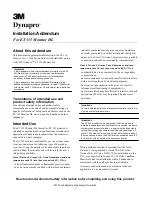
PULSAR
®
PLUS III-S, III-S6, and VI-S SUCTION BLAST CABINETS
Page 5
© 2021 CLEMCO INDUSTRIES CORP.
www.clemcoindustries.com
Manual No. 30421
buildup on the cartridge. Refer to Section 7.14 to replace
the filter cartridge.
1.7 Cabinet and Power-Module Controls and
Functions
Foot Pedal:
When the cabinet is set up and operational,
blasting begins when the foot pedal is pressed and
blasting stops when the pedal is released.
Door Interlocks:
The door interlocks disable blasting
when either cabinet door is open. To enable blasting, the
doors must be closed and the door interlock switches
engaged. Refer to Section 5.6 to adjust door interlocks.
Dustbin Interlock:
The dustbin interlock disables
blasting when the dustbin is removed or not fully clamped
in place. To enable blasting, the bin must be correctly
positioned and securely clamped. Refer to Section 5.7 to
adjust the dustbin interlock switch
Dust-Collector Pulse Pressure:
The pulse-pressure
regulator controls filter cartridge cleaning-pressure.
Lower pressure is needed when the filter cartridge is
newer and has only a light dust cake. Higher pressure is
needed to push the dust away from the cartridge when it
is heavily loaded with dust. Refer to Section 5.8 for
adjustment procedure.
NOTE: Pressure should be set
to zero (0 psi) until the filter cartridge is seasoned.
Dust-Collector Pulse Timing:
Pulse timing is controlled
with the digital pulse timer. The pulse sequence
automatically begins when the exhauster is turned ON.
Refer to Section 5.9 to adjust the pulse timer.
1.8
Nozzle Options
1.8.1
Unless otherwise specified at the time of
purchase, the cabinet is provided with a No. 5 (5/16"
orifice) ceramic nozzle and No. 5 (5/32" orifice) air jet.
Optional, more durable tungsten carbide and boron
carbide nozzles are available and are shown in
Section
10.1: Optional Accessories
and in Section 10.8 BNP Gun
and Feed Assembly.
Use boron carbide nozzles when
blasting with aggressive media, as noted in Section
1.11.4.
1.9
HEPA (high-efficiency particulate air)
Filter
1.9.1
An optional HEPA afterfilter provides additional
filtration, trapping 99.97% of dust down to 0.3 micron
particles. A HEPA filter must be used when removing
toxic coatings, heavy metals, or any other toxic
materials. HEPA filter is listed in
Section 10.1: Optional
Accessories
.
All dust is hazardous to breath.
Emissions can
occur from the dust-collection system. Identify
all materials that are to be removed by blasting.
If any toxic materials, such as lead dust or dust
from other heavy metals and corrosives, or any
other toxic materials are being removed, use a
HEPA afterfilter to assist in maintaining
inhalation hazards below the permissible
exposure limits (PELs). Prolonged exposure to
any dust can result in serious lung disease and
death. Short-term ingestion of toxic materials
can cause serious respiratory injury or death.
Filtration may not be adequate in reducing all
inhalation hazards. It remains the employer’s or
user’s responsibility to ensure all emissions are
safe to breath.
1.10
Reclaimer Options
1.10.1
Replaceable rubber reclaimer liners:
Rubber
liners are available for Pulsar Plus VI-S (600 cfm)
reclaimers. Liners are not available for the Pulsar Plus
III-S, with a 300 cfm reclaimer. The liners prolong service
life of the reclaimer and should be installed when using
silicon carbide, aluminum oxide, or other aggressive
media, as noted in Section 1.11.4.
Rubber liners are
shown on Page 47, Figure 57.
1.11
Blasting Media
1.11.1
Always use media specifically manufactured for
blasting and those that are compatible with the surface
being blasted. Media produced for other applications
may be inconsistent in size and shape, contain particles
that could plug the nozzle or media metering valve, or
cause irregular wear. Always obtain the safety data
sheet (SDS) for the blasting media prior to blasting and
identify material being removed by blasting, paying
attention to worker health risks and the presence of any
hazardous/toxic substances.
Most common reusable media specifically manufactured
for blasting can be used in Pulsar
®
Plus Cabinets. The
media sizes shown in this section and in Figure 3 are
provided as a guideline only. The guideline is based on
standard 5/32" orifice air jet with 5/16" nozzle and
average conditions with variables such as blast
pressure, media-air mixture, visibility inside the cabinet,
humidity, and reclaimer cleaning rate.
Several variables affecting the reclaimer cleaning rate
include reclaimer size (cfm), contamination of parts
being blasted, media friability, damper setting (static







































